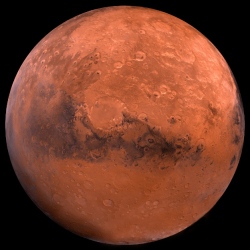
A team of scientists at NASA’s Johnson Space Center in Houston and the Jet Propulsion Laboratory in Pasadena, Calif., has found evidence of past water movement throughout a Martian meteorite, reviving debate in the scientific community over life on Mars.
In 1996, a group of scientists at Johnson led by David McKay, Everett Gibson and Kathie Thomas-Keprta published an article in Science announcing the discovery of biogenic evidence in the Allan Hills 84001(ALH84001) meteorite. In this new study, Gibson and his colleagues focused on structures deep within a 30-pound (13.7-kilogram) Martian meteorite known as Yamato 000593 (Y000593).
The team reports that newly discovered different structures and compositional features within the larger Yamato meteorite suggest biological processes might have been at work on Mars hundreds of millions of years ago.
The team’s findings have been published in the February issue of the journal Astrobiology. The lead author, Lauren White, is based at the Jet Propulsion Laboratory. Co-authors are Gibson, Thomas-Keprta, Simon Clemett and McKay, all based at Johnson. McKay, who led the team that studied the ALH84001 meteorite, died a year ago.
"While robotic missions to Mars continue to shed light on the planet’s history, the only samples from Mars available for study on Earth are Martian meteorites," said White. "On Earth, we can utilize multiple analytical techniques to take a more in-depth look into meteorites and shed light on the history of Mars. These samples offer clues to the past habitability of this planet.
As more Martian meteorites are discovered, continued research focusing on these samples collectively will offer deeper insight into attributes which are indigenous to ancient Mars. Furthermore, as these meteorite studies are compared to present day robotic observations on Mars, the mysteries of the planet’s seemingly wetter past will be revealed."
